Prepare to be amazed by a vegan ricotta cheese so exquisitely delicious, you’ll genuinely forget it’s dairy-free. This plant-based ricotta recipe isn’t just easy to master with a handful of simple ingredients; it delivers an unparalleled taste and texture that perfectly mimics traditional ricotta. Get ready to fall in love with a dairy-free ricotta cheese that promises all the richness, creaminess, and authentic feel you adore, crafted from wholesome, real food.

Are you eager to incorporate more plant-based meals into your diet but find the thought of giving up cheese daunting? Good news! You absolutely don’t have to. Our homemade vegan ricotta cheese is so luxuriously creamy and full of savory flavor that it effortlessly replaces its dairy counterpart, often surpassing expectations.
Forget about highly processed vegan cheese alternatives laden with unpronounceable ingredients. This recipe prides itself on using only real, whole food ingredients, making it refreshingly simple to prepare and incredibly satisfying. The secret? Cauliflower and almonds! Yes, “cauliflower ricotta” is a delightful culinary innovation that offers a light, nutritious, and unbelievably tasty foundation for this versatile dairy-free cheese.
Among the myriad of vegan nut cheeses available, this stands out as one of the easiest and most flavorful you’ll ever make. Its versatility is truly endless, ready to elevate both sweet and savory dishes. An added bonus: this almond ricotta recipe is brimming with healthy ingredients, ensuring you get pure goodness with every spoonful.
You’ll find yourself reaching for this incredible vegan ricotta cheese to enhance all your cherished Italian recipes. Imagine it generously layered in a classic lasagna, enriching elegant zucchini rollatini, transforming simple ricotta toast into a gourmet experience, or becoming the perfect creamy base for your pizza. Beyond Italian mainstays, it’s heavenly as a vibrant spread in wraps and sandwiches, proving its adaptability in countless culinary adventures.
The Rise of Plant-Based Living: Why Vegan Ricotta?
The journey towards a more plant-based lifestyle often brings questions about cherished foods, and cheese is frequently at the top of that list. For many, the creamy, tangy texture of ricotta cheese is indispensable in their favorite dishes. This vegan ricotta offers a brilliant solution, allowing you to enjoy all the culinary traditions you love, without any dairy.
Choosing a vegan ricotta isn’t just about dietary restrictions; it’s a conscious choice that brings a multitude of benefits. From a health perspective, this recipe is naturally lower in saturated fat and cholesterol, thanks to its plant-based origins. It’s also packed with nutrients from cauliflower and healthy fats from almonds, contributing to a well-rounded diet.
Beyond personal health, embracing dairy-free alternatives like this ricotta aligns with ethical and environmental considerations. It’s a compassionate choice that supports animal welfare and a sustainable food system, reducing the ecological footprint often associated with traditional dairy production. Plus, for those with lactose intolerance or dairy allergies, this recipe is a game-changer, opening up a world of culinary possibilities that were once off-limits.
This recipe ensures you don’t compromise on flavor or texture when making the switch. It’s a testament to how innovative plant-based cooking can be, creating alternatives that not only satisfy but truly delight the senses. Get ready to experience the creamy richness of ricotta, reimagined for a modern, healthier, and more sustainable plate.
Ingredients Spotlight & Smart Substitutions for Your Vegan Ricotta

Crafting the perfect vegan ricotta starts with understanding the role each ingredient plays. Here’s a closer look at what goes into this dairy-free delight and how you can tailor it to your pantry and preferences:
- Cauliflower: This unsung hero adds incredible bulk and a subtly sweet, neutral flavor that forms the perfect base for our ricotta. It contributes essential nutrition and helps create the desired creamy, yet slightly chunky texture without relying on heavy fats. Crucially, it helps keep this recipe naturally lower in fat, carbohydrates, and calories, making it a healthy powerhouse.
- Slivered almonds: Slivered almonds are ideal because their skins are already removed, which is essential for achieving a smooth, creamy vegan cheese texture without any grittiness. They provide a rich, nutty flavor and a good source of healthy fats. If almonds aren’t an option, soaked cashews or even pine nuts can be excellent alternatives, though almonds often offer a more budget-friendly and readily available choice with a distinct, pleasant flavor. Ensure any nut substitute is blanched or skinless for the best texture.
- Lemon juice: A crucial acidic component that provides the characteristic tanginess of traditional ricotta. Freshly squeezed lemon juice brightens the overall flavor profile. If lemons aren’t handy, rice vinegar can serve as a suitable substitute, offering a similar tartness. For an extra layer of citrus aroma, consider adding a touch of lemon zest – it elevates the flavor beautifully.
- Garlic: Fresh garlic cloves infuse the ricotta with a depth of savory flavor. For even distribution and a smooth finish, I highly recommend using a microplane zester to finely grate the garlic, ensuring it blends seamlessly into the mixture.
- Olive oil: Just two tablespoons of good quality olive oil significantly contribute to the ricotta’s creamy mouthfeel and richness. While you can opt for an oil-free version by substituting water or even some of the reserved cauliflower cooking water, the olive oil truly enhances the overall luxurious texture and flavor without adding excessive fat.
- Italian spices: A classic blend of dried oregano and thyme, combined with sea salt and freshly cracked black pepper, provides the quintessential herbaceous and savory notes expected in a rich ricotta. Feel free to adjust these to your taste, or even add a pinch of garlic powder or onion powder for extra depth.
Why This Recipe Will Become Your New Favorite Dairy-Free Staple

Once you try this vegan ricotta, you’ll understand why it’s destined to be a permanent fixture in your kitchen. Here’s an expanded look at the many reasons to love it:
- Truly Delicious & Satisfying: This isn’t just a good “vegan” alternative; it’s genuinely delicious in its own right. It boasts a rich, creamy, and undeniably cheesy flavor profile, coupled with a perfectly authentic ricotta-like texture that will satisfy even the most discerning palates.
- Effortlessly Easy to Make: Simplicity is key! This recipe requires minimal effort and just a few readily available ingredients. You won’t spend hours in the kitchen, making it perfect for both busy weeknights and special occasions.
- Incredibly Versatile: The possibilities are truly endless. Use it anywhere you’d use traditional ricotta – from savory Italian classics like lasagna and stuffed shells, to sweet applications like fruit tarts and pancakes. Its dairy-free nature means everyone, including those with allergies or dietary preferences, can enjoy it.
- A Healthy Choice: Embrace plant-based goodness! Made from whole, unprocessed ingredients, this ricotta is naturally low in saturated fat and calories, while being nutrient-dense. It’s a smart addition to a health-conscious diet.
- No Soaking Required: Unlike many nut-based vegan cheese recipes that demand hours of pre-soaking, this recipe is ready when you are. The use of slivered almonds and cooked cauliflower eliminates the need for advanced planning, allowing for spontaneous culinary creations.
- Completely Soy-Free: While tofu is a wonderful ingredient in many vegan dishes, for those avoiding soy, this cauliflower and almond combination is the perfect, tasty answer. Enjoy delicious vegan cheese without any soy, making it suitable for more dietary needs.
- Pure Plant-Based Goodness: Enjoy the cheesy flavor and creamy texture without the saturated fats found in conventional dairy cheese or the often-processed ingredients in store-bought vegan alternatives. It’s clean eating that doesn’t sacrifice taste.
- Perfect for Meal Prep: Whip up a batch at the start of the week, and you’ll have a delicious, versatile ingredient ready to transform quick dinners in a flash. Its excellent shelf life makes meal planning a breeze.
- Budget-Friendly: Making your own vegan ricotta at home is significantly more economical than purchasing often expensive store-bought vegan cheeses. Enjoy gourmet taste without breaking the bank.
- Kosher for Passover: For those observing Passover, finding delicious and compliant plant-based options can be challenging. This recipe is a total game-changer, making it a must-have for all your plant-based Passover meals!
Crafting Your Homemade Vegan Ricotta: A Step-by-Step Guide
Making your own luscious vegan ricotta is simpler than you think! Follow these easy steps to achieve a perfectly creamy and flavorful result.
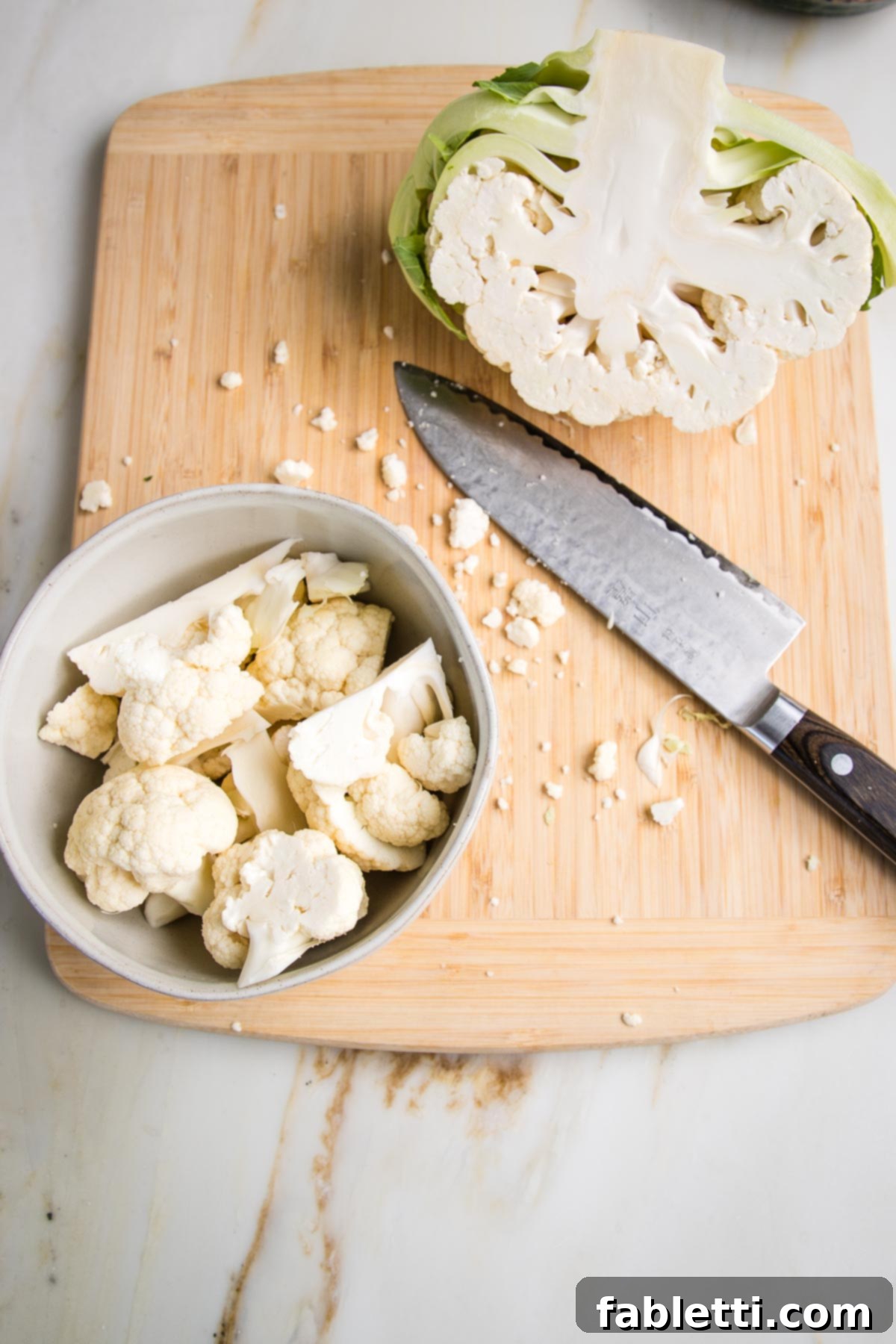
First things first: prepare your cauliflower. Begin by cutting the head in half, then remove the core and any leaves. Break or cut the cauliflower into florets. Since these will be processed in a food processor, a rough chop is perfectly fine; no need for perfect uniform pieces.

Next, you’ll steam the cauliflower until tender. If you have a steamer basket, place the florets in it over about an inch of boiling water, then cover and steam. If you don’t have a steamer basket, no worries! Use a small pot, add the cauliflower florets and then about an inch of water to the bottom. Bring the water to a rolling boil, then reduce the heat to a simmer, cover the pot tightly, and cook for approximately 12 minutes. The cauliflower should be fork-tender but not mushy—it’s crucial to avoid overcooking to maintain the best texture. Once cooked, promptly drain the cauliflower into a colander, allowing all excess water to escape.
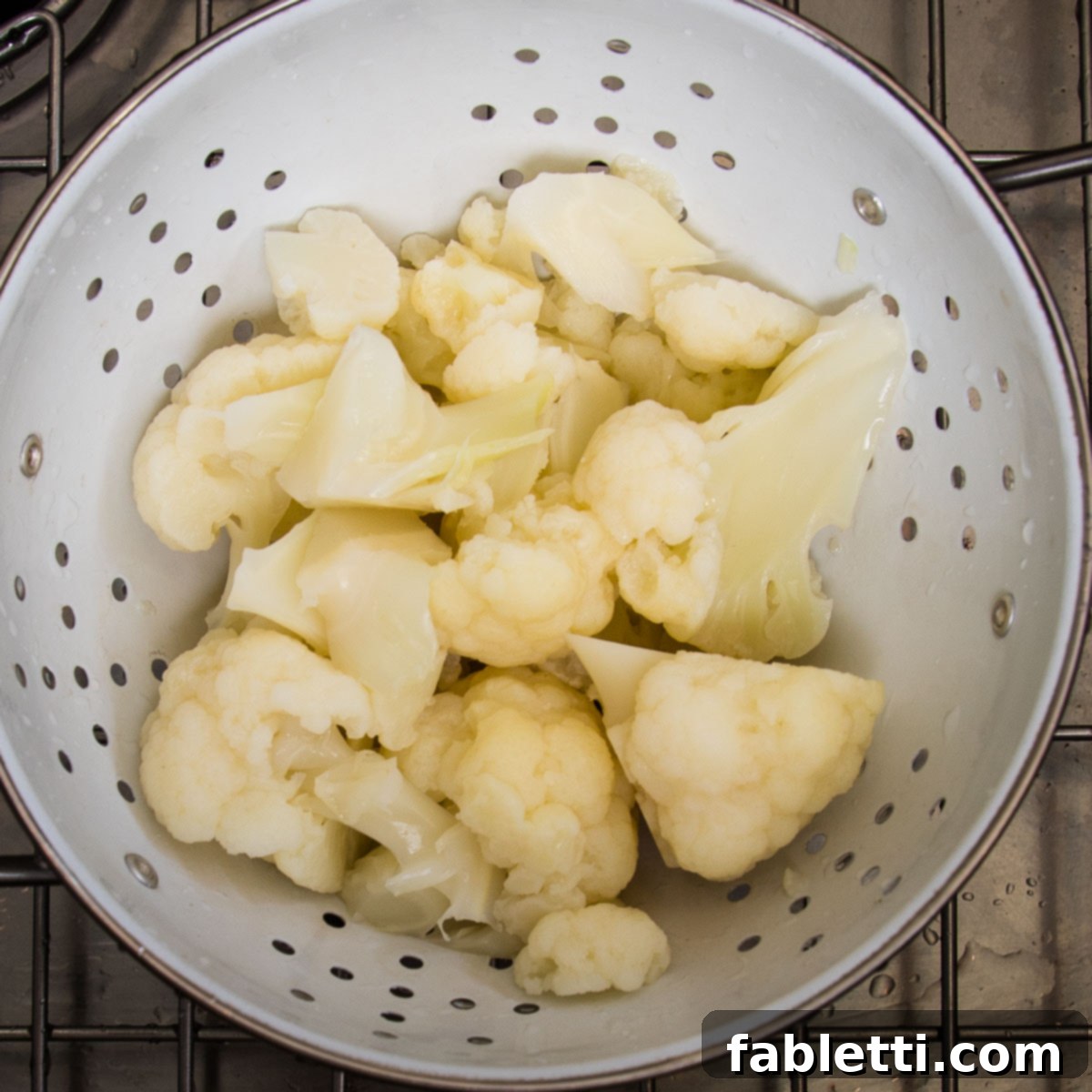
The cauliflower is ready when it offers little resistance when pierced with a fork, but still holds its shape. Avoid making it too soft, as this can result in a watery ricotta. Proper draining is also key here to prevent excess moisture from making your ricotta thin.
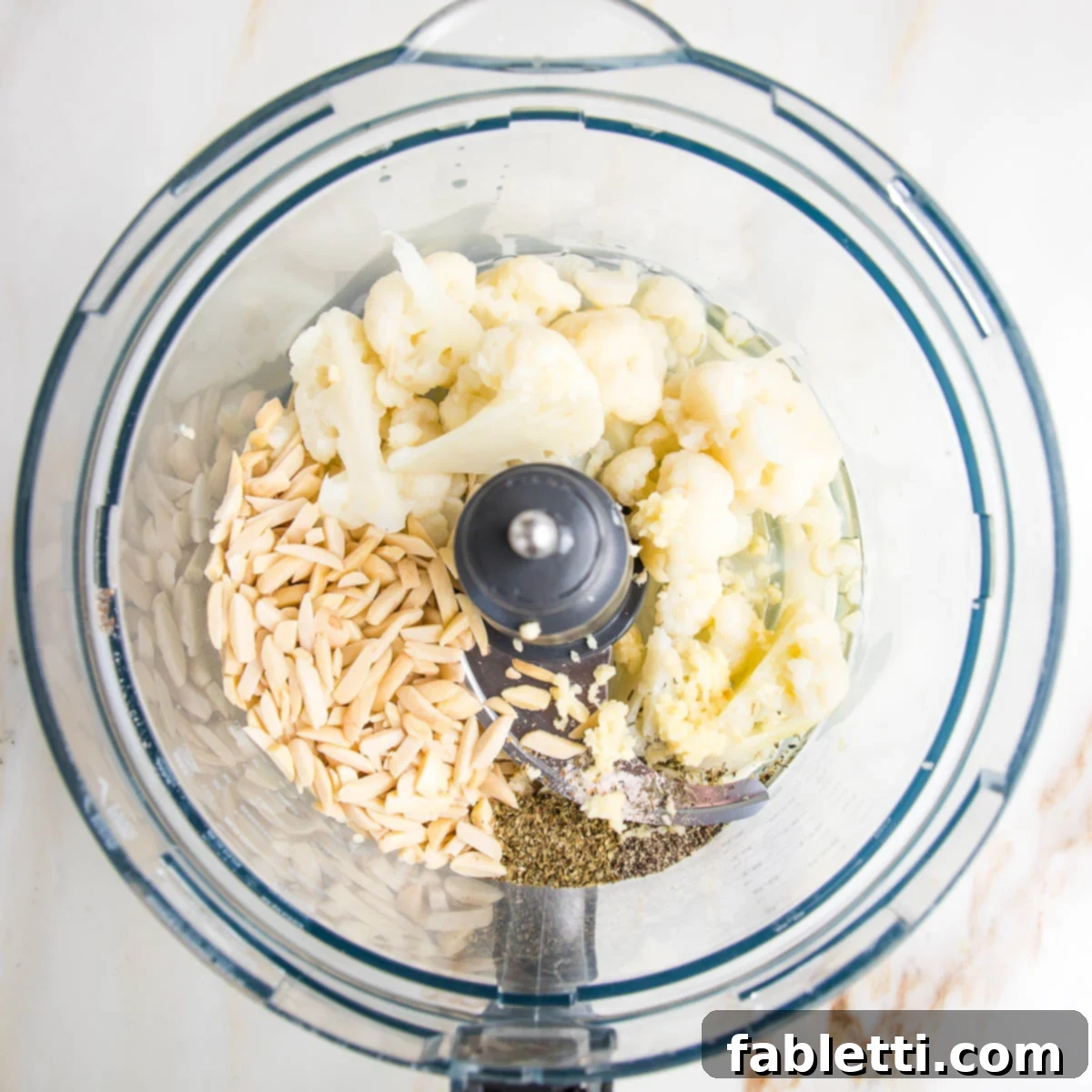
A food processor is undeniably the easiest and most efficient tool for this recipe. Carefully transfer the drained, steamed cauliflower, slivered almonds, finely zested garlic, fresh lemon juice, olive oil, dried oregano, dried thyme, sea salt, and freshly ground black pepper into the bowl of your food processor. Add the initial 2 tablespoons of water.

Pulse the mixture until everything is uniformly chunky. It’s important to stop and scrape down the sides of the bowl frequently to ensure all ingredients are incorporated evenly. Now is the perfect time to taste the mixture and adjust seasonings. You might find that another teaspoon of lemon juice adds a welcome burst of tanginess, or perhaps a little more salt or pepper is needed to suit your preference. Don’t be shy about seasoning to taste!
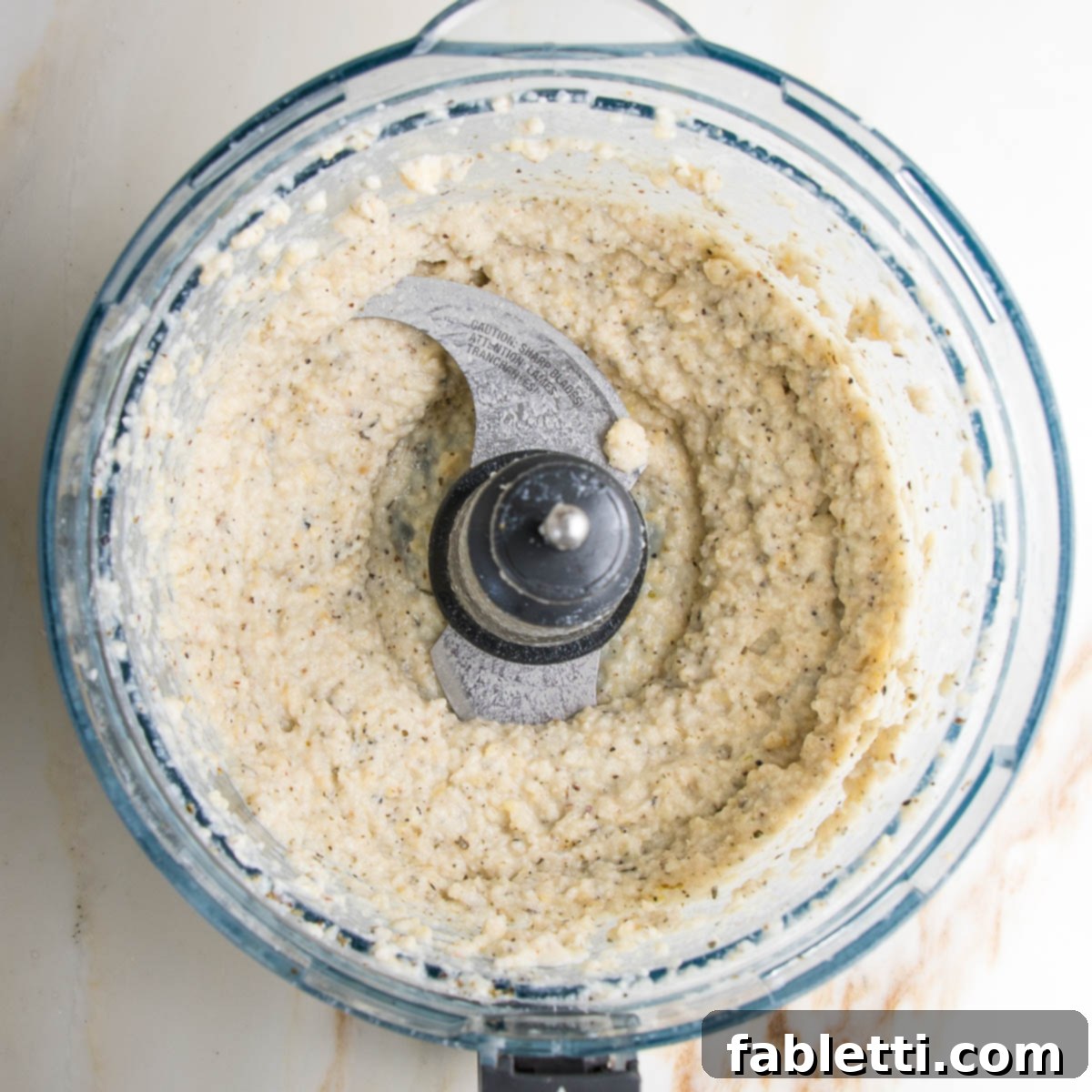
Continue to pulse until you reach your desired consistency. For a creamier ricotta, you may need to add an additional tablespoon or two of water, pulsing until it’s smooth but still retains a slight texture – remember, traditional ricotta isn’t completely silky. Avoid over-processing to keep that appealing, artisanal chunky quality. This gradual pulsing and occasional liquid addition is key to perfecting the texture.

Congratulations! Your homemade vegan ricotta cheese is now ready to use immediately. For future enjoyment, transfer it to an airtight container and store it in the refrigerator for up to a week, or freeze it for up to 3 months. Enjoy the versatility and deliciousness of your homemade dairy-free creation!
Debra’s Pro Tips for Ricotta Perfection
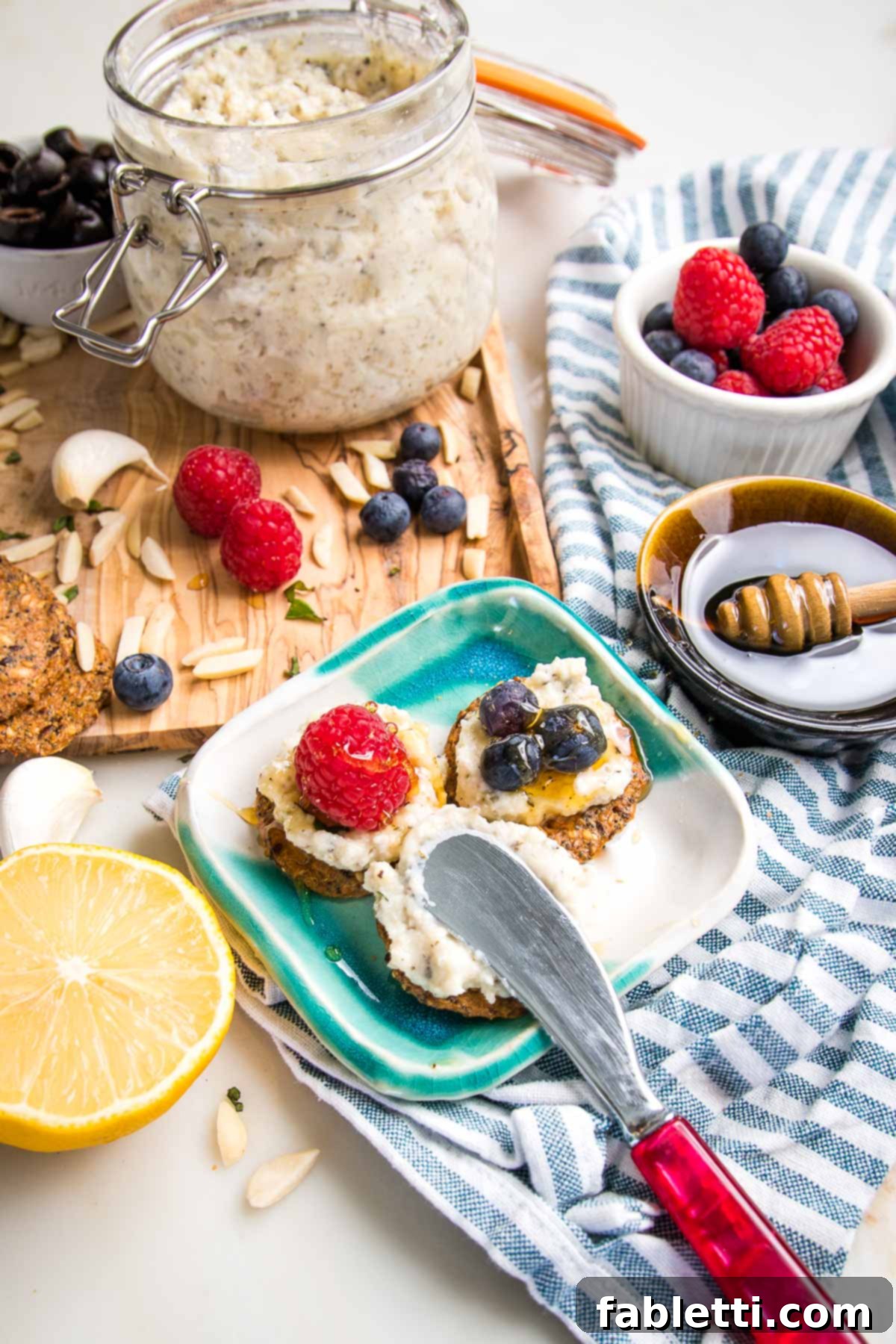
Mastering this vegan ricotta recipe is all about a few key techniques and creative serving ideas. Here are my best pro tips to ensure your homemade dairy-free ricotta is always a success and incredibly versatile:
- Customize Your Texture: The beauty of homemade ricotta is that YOU are in control. For a super smooth and creamy texture, allow your food processor to run a little longer. If you prefer a more rustic, chunkier ricotta with visible almond bits, pulse only until just combined, maintaining that delightful textural contrast. Experiment to find your perfect preference!
- Elevate Your Pizza: Vegan Ricotta Cheese is an absolute game-changer when spread onto a flatbread pizza. Top it generously with your favorite olives, fresh herbs like basil or oregano, and a sprinkle of red pepper flakes for an irresistible meal. The creamy ricotta balances the savory toppings beautifully.
- A Sweet & Simple Treat: For a delightful snack or dessert, try spreading a dollop of this vegan ricotta on a cracker. Crown it with fresh berries like raspberries or blueberries, and finish with a delicate drizzle of honey or date syrup. It’s an unexpectedly delicious combination that creates a new fan every time!
- Smart Freezing for Future Use: Don’t let any go to waste! Freeze your vegan ricotta in practical one-cup or half-cup increments using silicone molds or freezer-safe containers. This makes it incredibly convenient to grab just the right amount for your favorite recipes without thawing the entire batch.
- Passover Essential: This recipe is an absolute staple for Passover. I often find myself doubling, or even tripling, the batch to ensure I have enough for all the plant-based Passover meals. It truly transforms the holiday menu.
- Hearty Lunch or Dinner: For a simple yet satisfying meal, stuff a baked sweet potato with a generous portion of vegan ricotta, then top with your favorite roasted vegetables. It’s a nutritious, flavorful, and incredibly easy lunch or dinner option.
- Flavor Boost with Lemon: If you’re looking to enhance the flavor without increasing the sodium, an extra teaspoon of lemon juice can work wonders. Its bright acidity amplifies the overall taste and freshness of the ricotta.
- Fresh Herbs for Garnish: Before serving, consider sprinkling your vegan ricotta with finely chopped fresh herbs like parsley, chives, or basil. This adds a pop of color and an extra layer of aromatic freshness that elevates any dish.
Versatile Serving Suggestions & Culinary Inspirations
One of the greatest joys of this homemade vegan ricotta is its incredible versatility. It’s not just a substitute; it’s an ingredient that can truly shine across a wide spectrum of dishes. Get ready to explore new culinary horizons with your delicious plant-based creation!
Meal Prep and Storage:
- Savory Creations: This vegan ricotta is a dream come true for your favorite savory recipes. Use it as a rich, creamy layer in baked lasagna, a delightful filling for stuffed shells, or elegantly rolled into zucchini roll-ups. For a simple yet gourmet appetizer, spread it on toasted bread or crostini and top with thinly sliced fresh tomatoes, a sprinkle of olives, and a drizzle of balsamic glaze.
- Sweet Delights: Don’t limit yourself to savory! Transform this ricotta into a sweet treat. Dollop it onto your morning pancakes or waffles for a creamy addition. Spread it on crackers and top with a few fresh blueberries and a light drizzle of honey or maple syrup for a delightful dessert or snack. For a truly indulgent experience, try using it as a filling for homemade vegan cannolis, or pair it with warm, grilled peaches for a sophisticated dessert.
- Prep Ahead for Convenience: Life gets busy, but delicious meals don’t have to be complicated. You can steam your cauliflower up to 3 days in advance and store it in the refrigerator. When you’re ready, simply blend it with the remaining ingredients. This vegan ricotta cheese is a fantastic meal prep component, maintaining its freshness and flavor in the fridge for up to 10 days.
- Optimal Storage: To maximize freshness and flavor, always store your vegan ricotta in an airtight container in the refrigerator. It will stay wonderfully fresh for up to 10 days, making it perfect for last-minute meal additions.
- Freezing for Long-Term Enjoyment: For longer storage, this ricotta freezes beautifully for up to 3 months. Use freezer-safe containers and ensure you pack the ricotta tightly, pressing out any excess air to prevent freezer burn. Thaw overnight in the refrigerator before using, and give it a quick stir to restore its creamy texture.
Whether you’re crafting a cozy weeknight dinner or preparing for a special gathering, this vegan ricotta cheese offers endless possibilities to infuse your meals with wholesome, plant-based goodness.
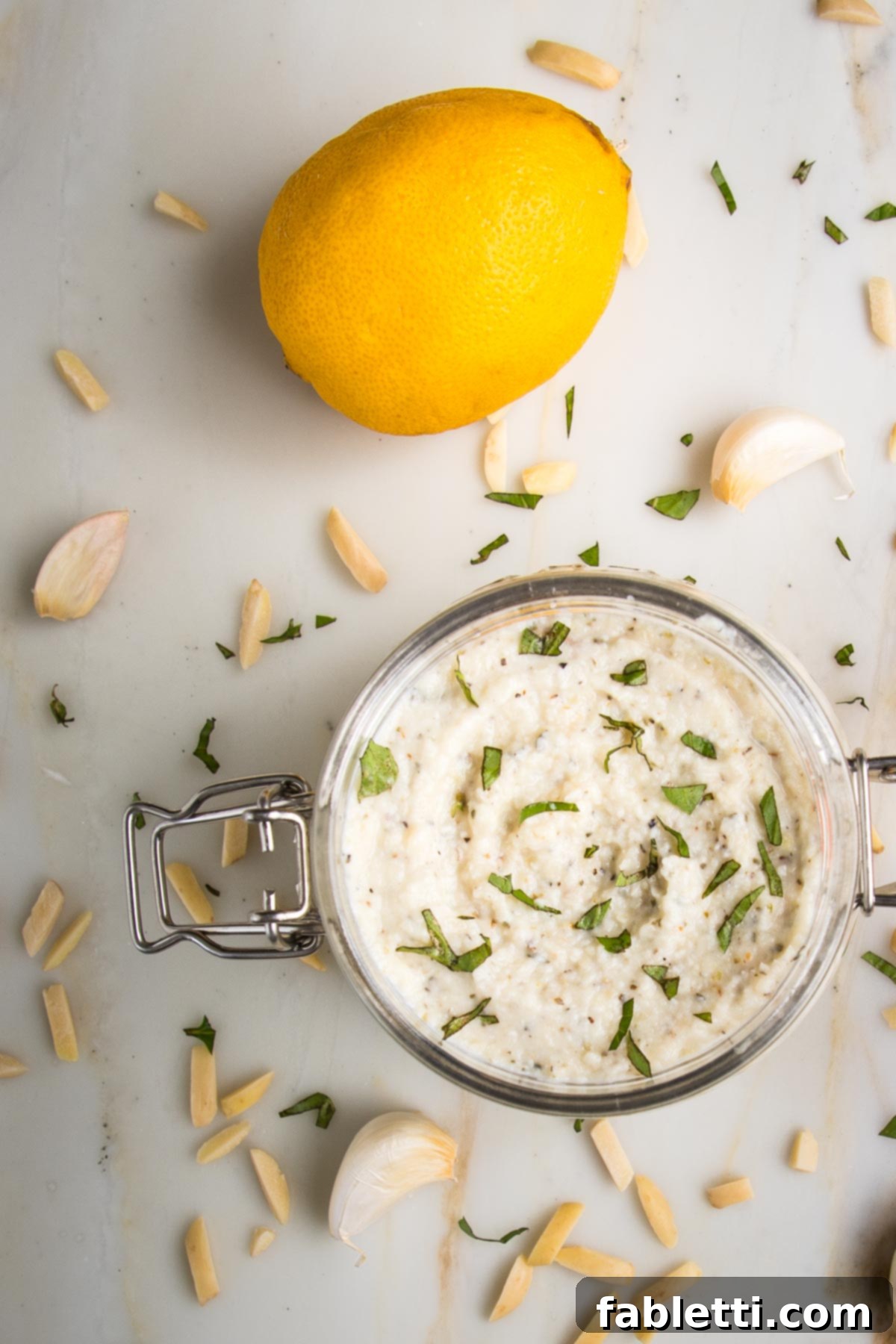
Frequently Asked Questions (FAQ) About Vegan Ricotta
Here are answers to some common questions you might have about making and using this delicious dairy-free ricotta:
- Can I use whole almonds instead of slivered almonds?
While slivered almonds are preferred for their skinless nature and ease of blending into a smooth consistency, you can use whole blanched almonds. If using raw, unblanched whole almonds, you might need to soak them in hot water for 30 minutes, then drain and peel off the skins for the creamiest result. - Is this recipe gluten-free?
Yes, this vegan ricotta recipe is naturally gluten-free as all ingredients are free from gluten. It’s a fantastic option for those with gluten sensitivities or celiac disease. - How can I make this recipe oil-free?
You can easily make this ricotta oil-free by simply replacing the olive oil with an equal amount of water, or even some of the reserved cauliflower cooking water. While the olive oil adds a certain richness and creaminess, the ricotta will still be delicious without it. - What if my ricotta is too thin or too thick?
If your ricotta is too thin, try adding a few more slivered almonds or a tablespoon of nutritional yeast (which also adds a cheesy flavor) and pulsing again. If it’s too thick, gradually add small amounts of water (1 tablespoon at a time) and pulse until you reach your desired consistency. - Can I add nutritional yeast for a cheesier flavor?
Absolutely! Nutritional yeast is a popular ingredient in vegan cooking for its cheesy, umami flavor. Feel free to add 1-2 tablespoons to the food processor along with the other ingredients for an extra boost of cheesy goodness. - How long does homemade vegan ricotta last?
When stored properly in an airtight container in the refrigerator, this vegan ricotta will stay fresh and delicious for up to 10 days. It can also be frozen for up to 3 months.
More Vegan Italian Recipes you will love:
- Vegan Basil Pesto Recipe
- Vegan Bolognese + Spaghetti Squash
- Vegan Stuffed Peppers Lentils
- Gluten-free Almond Flour Biscotti
Your feedback makes a huge difference! If you’ve enjoyed making this recipe, please consider leaving a five-star rating and a comment below. Sharing your culinary creations is also a wonderful way to inspire others. Don’t forget to share your photos on Instagram by tagging me @dkhealthcoach and using the hashtag #debraklein. I can’t wait to see your delicious results!
📖 Recipe: Easy Homemade Vegan Ricotta
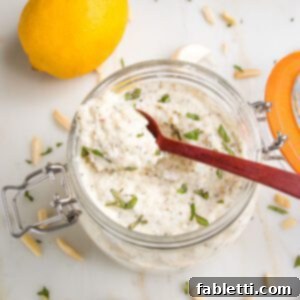
Vegan Ricotta Recipe
Rate this Recipe
Pin Recipe
Equipment
- Food Processor
- Microplane
- Sauce Pan with Lid
Ingredients
- 2 cups cauliflower florets (about ½ head cauliflower)
- 1 cup slivered almonds
- 2 cloves garlic (peeled and grated)
- 1 Tablespoon lemon juice
- 2 Tablespoons olive oil
- 1 teaspoon dried oregano
- ½ teaspoon dried thyme
- ½ teaspoon coarse sea salt
- ½ teaspoon freshly ground pepper
- ¼ cup water
Instructions
- Prepare Cauliflower: Start by washing your cauliflower head thoroughly. Cut it in half, then trim off any leaves and the tough stem. Break or cut the cauliflower into small florets. A rough chop is fine as they will be processed later.
- Steam Cauliflower: To steam, you can use a steamer basket over boiling water. Alternatively, if you don’t have one, place the cauliflower florets directly into a small pot with a tight-fitting lid, adding about ½ inch of water to the bottom. Bring the water to a boil, then reduce the heat to medium-low, cover the pot, and let the cauliflower steam for about 12 minutes. It should be tender enough to pierce easily with a fork, but not mushy. Promptly drain the steamed cauliflower into a colander to remove all excess water, which is crucial for the ricotta’s texture.
- Blend Ingredients: Transfer the drained, steamed cauliflower, slivered almonds, finely grated garlic (using a microplane for best results), lemon juice, olive oil, dried oregano, dried thyme, coarse sea salt, freshly ground pepper, and 2 tablespoons of water into the bowl of your food processor. Pulse the mixture until all ingredients are well combined and the mixture is uniformly chunky. Stop and scrape down the sides of the bowl frequently to ensure even blending. Taste the mixture and adjust seasonings as needed; you might want an additional teaspoon of lemon juice for more tanginess, or extra salt and pepper to suit your preference. Continue processing until creamy but still with a desirable ricotta-like texture – it should not be entirely smooth. If you desire a creamier consistency, gradually add another tablespoon or two of water, pulsing until achieved.
- Serve or Store: Your delicious vegan ricotta is now ready to be used immediately in any of your favorite recipes! For storage, transfer it to an airtight container. It will stay fresh and flavorful in the refrigerator for up to 10 days, or you can freeze it for up to 3 months for longer-term enjoyment.
Video
Notes
CAULIFLOWER CONSISTENCY: Ensure your cauliflower is cooked just right – tender but not mushy – to achieve the ideal texture for your ricotta. Overcooked cauliflower can result in a watery or overly smooth consistency.
SEASONING TO TASTE: Don’t hesitate to adjust the salt, pepper, and lemon juice to your personal preference. A little extra seasoning can make a big difference in the final flavor.
Nutrition
Note
The nutrition calculations were done using online tools. To obtain the most accurate representation of the nutritional information in any given recipe, you should calculate the nutritional information with the actual ingredients you used. You are ultimately responsible for ensuring that any nutritional information is accurate, complete and useful.
